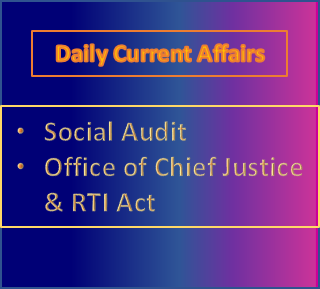CURRENT AFFAIRS
Get the most updated and recent current affair content on Padhaikaro.com
Social Auditing & Office of Chief Justice & RTI Act
- Vaid's ICS, Lucknow
- 21, Oct 2020


Why in news?
In line with Government’s objective of bringing Good Governance through Transparency, Participation and Accountability in all Government Schemes, Ministry of Rural Development has decided to institutionalize social audits in its major schemes.
What is social audit?
- Social Audit is recognized by the Comptroller and Auditor General (CAG), as a powerful tool to enforce transparency and accountability.
- Mahatma Gandhi National Rural Employment Guarantee Act (MGNREGA) was the first Act to mandate Social Audits by the Gram Sabha of all the projects taken up in the Gram Panchayat.
- According to MGNREGA act, 2005: ‘The Gram Sabha Shall Conduct Regular Social Audits of all the Projects under the scheme taken up within the Gram Panchayat’.
- MGNREGA Audit of Schemes Rules was passed by the Central Government, in consultation with the Comptroller and Auditor General (C&AG) in 2011.

More about
- To begin with, Social Audit Guidelines have been released for National Social Assistance Program (NSAP) and Pradhan Mantri Awas Yojana –Grameen (PMAY-G).
- Ministry of Rural Development also released the report ‘Status of Social Audits in India’.

Front runner states in social audit programme:
- Meghalaya Legislature has enacted ‘The Meghalaya Community Participation and Public Services Social Audit Act, 2017’ which mandates social audit in 26 different schemes in Education, Health, Rural Development and other areas.
- Pradhan Mantri Aawas Yojana-Gramin (PMAY-G) audits are done in Uttar Pradesh, Meghalaya and West Bengal.
- National Social Assistance Programme (NSAP) audits are done in Andhra Pradesh and West Bengal.


Why in news?
The office of the Chief Justice of India (CJI) is a ‘public authority’ under the Right to Information (RTI) Act, a five-judge Constitution Bench led by Chief Justice of India Ranjan Gogoi declared recently.
- RTI stands for Right to Information and has been given the status of a fundamental right under Article 19(1) of the Constitution Right to Information (RTI) Act 2005 mandates timely response to citizen requests for government information by various Public Authorities under the government of India as well as the State Governments.
- The law imposes a penalty for willful default by government officials. Citizens can ask for anything that the government can disclose to Parliament.
Significant Provisions under Right to Information Act, 2005 :
Section 2(h): Public authorities means all authorities and bodies under the Constitution or any other law, and inter alia includes all authorities under the Central, state governments and local bodies. The civil societies substantially funded, directly or indirectly, by the public funds also fall within the ambit.
Section 4 1(b): Maintain and proactively disclose information.
Section 6: Prescribes simple procedure for securing information.
Section 7: Fixes time limit for providing information(s) by PIOs.
Section 8: Only minimum information exempted from disclosure.
Section 19: Two tier mechanism for appeal.
Section 20: Provides penalties in case of failure to provide information on time, incorrect, incomplete or misleading or distorted information.
Section 23: Lower courts are barred from entertaining suits or applications. However, the writ jurisdiction of the Supreme Court and high courts under Articles 32 and 225 of the Constitution remains unaffected.
Achievements of Right to Information (RTI) Act, 2005 :
- The answer keys of civil service examination and IIT-JEE are now available on the websites of the Union Public Service Commission and IIT-JEE respectively, helping students to find out their scores even before the official announcement.
- Assets and wealth declaration of all public servants – PM and his entire council of ministers, civil servants — are now in the public domain.

Criticism of Right to Information (RTI) Act, 2005
- Poor record-keeping practices within the bureaucracy results in missing files.
- Lack of infrastructure and staff for running Information Commissions.
- Dilution of supplementary laws such as the one for whistleblower protection.
- Lack of Proactive declaration of information by the government as stipulated in RTI law increase applications.
- Need to put all RTI replies on government websites to curb unnecessary applications.
- Increasing frivolous RTI applications. (Public authorities have also complained some applicants of using RTI for blackmail).
How does Right to Information (RTI) Act work?
Every citizen has freedom of speech and expression. Therefore, Citizens have a right to know how the governments, meant to serve them, are functioning.
The Right to Information Act (RTI), 2015 is an Act of the Parliament of India – to provide for setting out the practical regime of right to information for citizens. ”Simply put, it allows citizens of the country to request information from any public authority about its work, actions, etc”
Facts for Prelims:
Pink Tide:
- The Pink Tide is used in contemporary 21st-century political analysis that refers to turn to the left, the left-wing government or left-leaning party have been in power in Latin America after the consecutive elections of Hugo Chávez in 1998 in Venezuela and Lula da Silva in Brazil.
- The Pink Tide is a reference to the nature of these political movements as they are not communists (red) but some more moderate version of the left (pink).